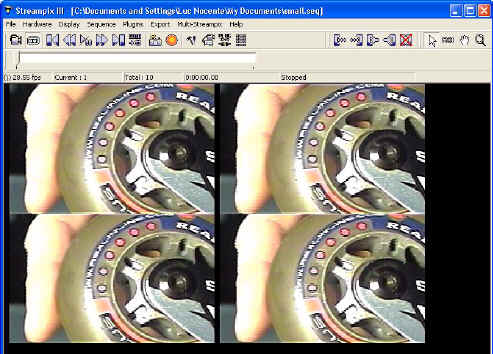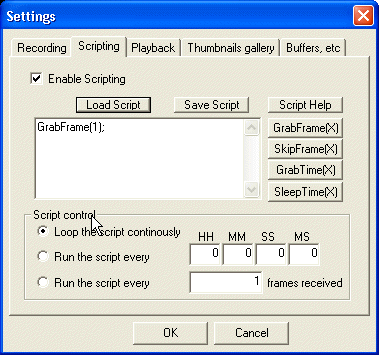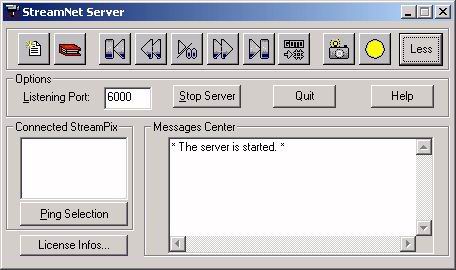
StreamPix
MegaCamera Digital Video Recorder (M-DVR)

Record live un-compressed or compressed video directly to your PC's RAM or hard disk drive in real time. Create movie clips in AVI or other file formats such as bmp, tiff, multi-tiff, mpeg or jpeg format. StreamPix guarantees no image drops when acquiring a sequence.
Features:
Real time uncompressed or compressed to RAM or hard disk drive
No raid or SCSI technology required (Use off the shelf PC's)
VCR Controls: record, play, rewind, fast forward, pause.
Save Images in bmp, tiff, and many others.
Record to AVI: Compressed or uncompressed format.
Microsoft Media Player Playback compatibility
Triggered Events
Time Lapse Recording
Continuous loop recording
Time/Date Stamping of each individual image.
Text Overlay
Thumbnail Viewer
Macros for customizing complex recording sessions.
Audio: Add audio to a sequence or an individual image.
Plug-In Module support for custom development using SDK
USB2.0, Cameralink & GigE-Cameralink support
Recording with Scritps

Scripting in StreamPix can be as simple or complex as you want. Understanding how it works will grant you an almost infinite flexibility in your recording session. So what is this scripting thing? Well, scripting is the description of the behavior of StreamPix during a recording. It is useful when you don't want to capture at full frame rate for the entire recording length. If you only want to capture at full frame rate, simply disable scripting using the check box at the top of the window.
A script can be formed of one or more script actions that will be read and interpreted sequentially. There are four script actions : GrabFrame, SkipFrame, GrabTime and SleepTime. Each action accepts only a single parameter. (By the way, each action must have an ";" appended to it as a separator).
GrabFrame(X); will tell StreamPix to grab the next X frames to come from the camera.
SkipFrame(X); will tell StreamPix to ignore the next X frames to come from the camera.
GrabTime(X); will tell StreamPix to grab all frames coming from the camera for the next X ms.
SleepTime(X); will tell StreamPix to ignore all frames coming from the camera for the next X ms.
Here is an example. Suppose the current script is:
GrabTime(1000);
SleepTime(2000);
GrabTime(2000);
SkipFrame(10);
GrabFrame(5);
Here is what would be done :
For the first second of the recording, every frame received would be saved.
Then, for the next 2 seconds, nothing would be done. Frames received would be displayed then discarded without saving them.
Once the 2 seconds of inactivity are done with, we will save every frame received for the next 2 seconds.
We would then wait for 10 frames to have been sent by the camera. Those 10 frames will be displayed, then discarded without saving them.
Finally, 5 frames would be received and saved, then the script would end.
Now that we have seen what a script is made of, let's see how we can use it. The script can be used in three different ways. The first, and most common, is to loop the script continuously as long as we are recording. So when the last action of the script is done, the script will be restarted and the first action will be launched. A good example is when you want to capture at half the frame rate (only save 1 frame every 2). Your script would be:
GrabFrame(1);
SkipFrame(1);
and because the control mode is set to continuous, StreamPix would do:
GrabFrame(1);
SkipFrame(1);
GrabFrame(1);
SkipFrame(1);
GrabFrame(1);
SkipFrame(1);
...
for the duration of the recording. In fact, when you disable recording, a
script is still used without your knowledge. The script is GrabFrame(1); and the
control mode is set to continuous.
Now
on to something completely different. Let's say you want to capture one
minute every hour. How would you do it? You would use the second
control method (time controlled).
So
your script would be:
GrabTime(60000); (60 sec * 1000 ms/sec)
And, you would set a control time of 01:00:00.00. So each hour, the script
would be restarted and one minute worth of images would be saved. In this
mode (as opposed to the continuous mode), the script is not automatically looped
when it reaches its end. It will simply sit there, waiting to be
restarted. By the way, if the previous script has not finished it's
execution when the time limit is reached, it is aborted and restarted
immediately.
Finally, the last control mode (frame controlled), works the same way as the second mode except that it is based on the number of frames to be received from the camera instead of a length of time.
StreamNet
- Multi-Camera Network M-DVR Server
StreamNet server is a complimentary module
that can control a multipe number of StreamPix applications running either on
the same or on a network of computers. StreamNet server will control all
StreamPix copies simultaneously in cases where you may need to acquire a
multitude of sequences at the same time.

Example: Capturing 3 sequences simultaneously from 3 different cameras at the same time.